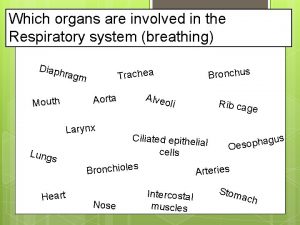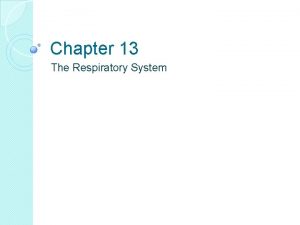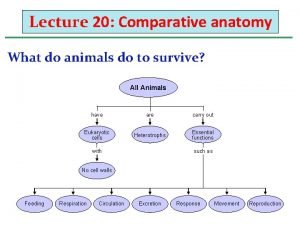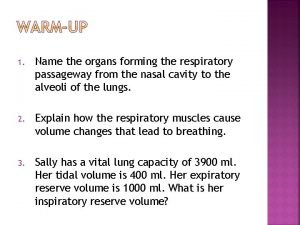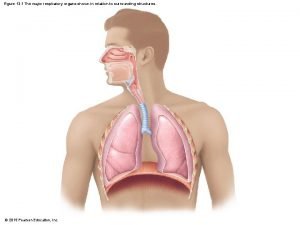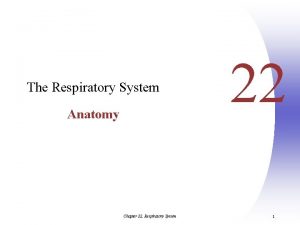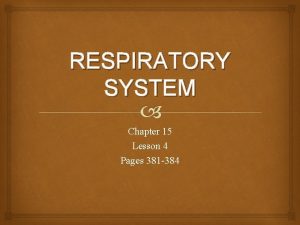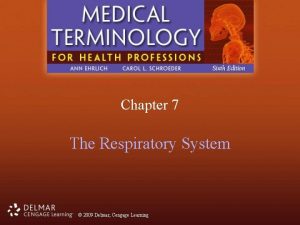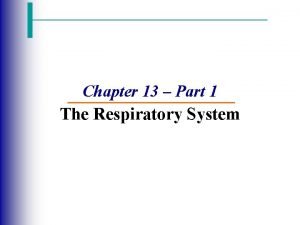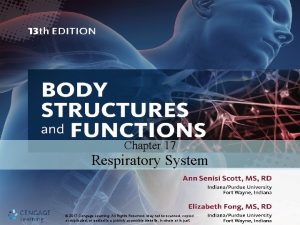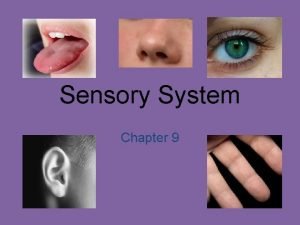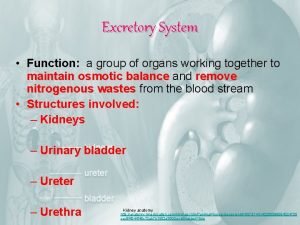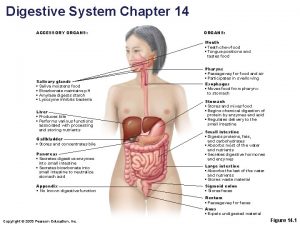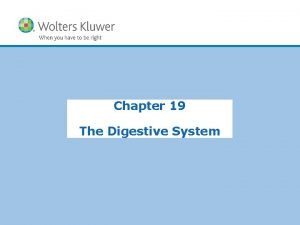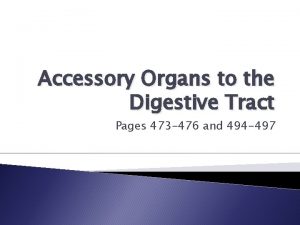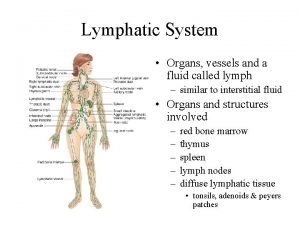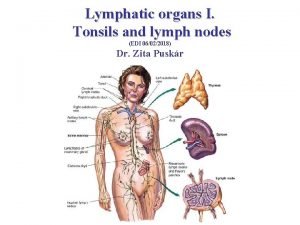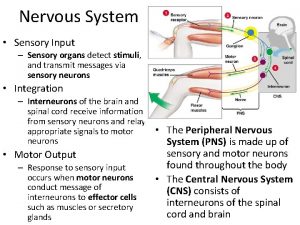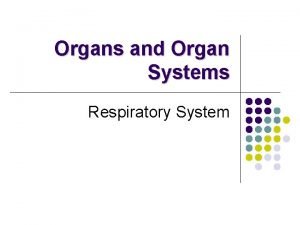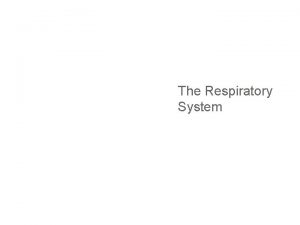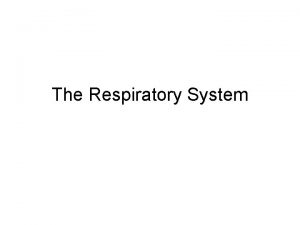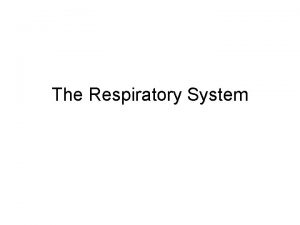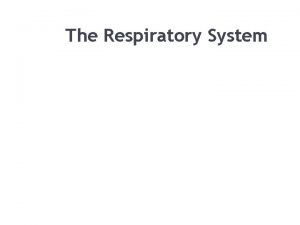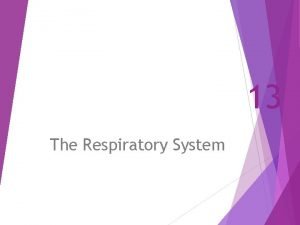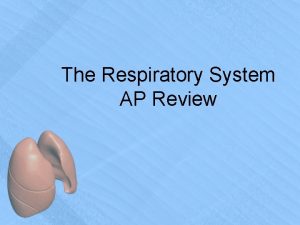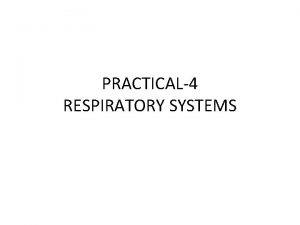Chapter 13 The Respiratory System Organs of the





























- Slides: 29

Chapter 13 The Respiratory System

Organs of the Respiratory System �Nose �Pharynx �Larynx �Trachea �Bronchi �Lungs— alveoli

Functions of the Respiratory System �Gas exchanges between the blood and external environment ◦ Occurs in the alveoli of the lungs ◦ Molecules move by passive diffusion �Ventilation: the rate at which gases enter/exit the lungs ◦ Controlled by the autonomic nervous system �The brain stem, medulla oblongata & pons �Passageways to the lungs purify, humidify, and warm the incoming air

The Nose �Only externally visible part of the respiratory system �Air enters the nose through the external nostrils (nares) �Interior of the nose consists of a nasal cavity divided

Anatomy of the nasal cavity � Olfactory receptors are located in the mucosa on the superior surface � The rest of the cavity is lined with respiratory mucosa that ◦ Moisten air ◦ Trap incoming foreign particles � Lateral walls have projections called conchae ◦ Increase surface area ◦ Increase air turbulence within the nasal cavity � The nasal cavity is separated from the oral cavity by the palate ◦ Anterior hard palate (bone) ◦ Posterior soft palate (muscle) � Sinuses bones ◦ ◦ are located in the following Frontal bone Sphenoid bone Ethmoid bone Maxillary bone

Pharynx (Throat) �Muscular passage from nasal cavity to larynx �Three regions of the pharynx ◦ Nasopharynx—superior region behind nasal cavity ◦ Oropharynx—middle region behind mouth ◦ Laryngopharynx—inferior region attached to larynx �The oropharynx and laryngopharynx are common passageways for

Pharynx (Throat) �Pharyngotympanic (Eustachian) tubes open into the nasopharynx �Tonsils of the pharynx ◦ Pharyngeal tonsil (adenoids) are located in the nasopharynx ◦ Palatine tonsils are located in the oropharynx ◦ Lingual tonsils are found at the base of the tongue

Larynx (Voice Box) � Routes air and food into proper channels � Plays a role in speech � Made of eight rigid hyaline cartilages and a spoon-shaped flap of elastic cartilage (epiglottis) � Thyroid cartilage ◦ Largest of the hyaline cartilages ◦ Protrudes anteriorly (Adam’s apple) � Epiglottis ◦ Protects the superior opening of the larynx ◦ Routes food to the esophagus and air toward the trachea ◦ When swallowing, the epiglottis rises and forms a lid over the opening of the larynx � Vocal folds (true vocal cords) ◦ Vibrate with expelled air to create sound (speech) � Glottis—opening cords between vocal

Trachea �Four-inch-long tube that connects larynx with bronchi �Walls are reinforced with C-shaped hyaline cartilage �Lined with ciliated mucosa ◦ Beat continuously in the opposite direction of incoming air ◦ Expel mucus loaded with dust and other debris away from lungs �Adventitia

Primary Bronchi & Bronchioles �Formed by division of the trachea �Enters the lung at the hilum (medial depression) �Right bronchus is wider, shorter, and straighter than left ◦ The heart occupies a large portion of the left lung area �Bronchi subdivide into smaller and smaller

Lungs & its coverings �Occupy most of the thoracic cavity ◦ Heart occupies central portion called mediastinum �Apex �Base is near the clavicle (superior portion) rests on the diaphragm (inferior portion) �Each lung is divided into lobes by fissures ◦ Left lung—two lobes ◦ Right lung—three lobes �Serosa covers the outer surface of the lungs ◦ Pulmonary (visceral) pleura covers the lung surface ◦ Parietal pleura lines the walls of the thoracic cavity �Pleural fluid fills the area between layers of pleura to allow gliding

Lungs & its coverings

Respiratory Zone �Structures ◦ ◦ Respiratory bronchioles Alveolar ducts Alveolar sacs Alveoli (air sacs) �Site of gas exchange = alveoli only �Alveolar pores connect neighboring air sacs �Pulmonary capillaries cover external surfaces of alveoli �On one side of the membrane is air and on the other side is blood flowing past

Gas Exchange �Gas crosses the respiratory membrane by diffusion ◦ Oxygen enters the blood ◦ Carbon dioxide enters the alveoli �Alveolar macrophages (“dust cells”) add protection by picking up bacteria, carbon particles, and other debris �Surfactant (a lipid molecule) coats gasexposed alveolar surfaces

Four Events of Respiration �Pulmonary ventilation—moving air in and out of the lungs (commonly called breathing) �External respiration—gas exchange between pulmonary blood and alveoli ◦ Oxygen is loaded into the blood ◦ Carbon dioxide is unloaded from the blood �Respiratory gas transport—transport of oxygen and carbon dioxide via the bloodstream �Internal respiration—gas exchange between blood and tissue cells in

Mechanics of Breathing: (Pulmonary Ventilation) �Completely mechanical process that depends on volume changes in the thoracic cavity �Volume changes lead to pressure changes, which lead to the flow of gases to equalize pressure �Two phases ◦ Inspiration = inhalation �flow of air into lungs ◦ Expiration = exhalation �air leaving lungs

Inspiration & Expiration �Inspiration ◦ Diaphragm and external intercostal muscles contract ◦ The size of the thoracic cavity increases ◦ External air is pulled into the lungs due to �Increase in intrapulmonary volume �Decrease in gas pressure �Expiration ◦ Largely a passive process which depends on natural lung elasticity ◦ As muscles relax, air is pushed out of the lungs due to �Decrease in intrapulmonary volume �Increase in gas pressure

Non-respiratory Gas Movements �Can be caused by reflexes or voluntary actions

Respiratory Volumes & Capacity � Normal breathing moves about 500 m. L of air with each breath ◦ This respiratory volume is tidal volume (TV) � Many ◦ ◦ factors that affect respiratory capacity A person’s size Sex Age Physical condition � Inspiratory reserve volume (IRV) � Expiratory reserve volume (ERV) ◦ Amount of air that can be taken in forcibly over the tidal volume ◦ Usually between 2100 and 3200 m. L ◦ Amount of air that can be forcibly exhaled ◦ Approximately 1200 m. L � Residual volume ◦ Air remaining in lung after expiration ◦ About 1200 ml

Vital Capacity �Vital capacity ◦ The total amount of exchangeable air ◦ Vital capacity = TV + IRV + ERV ◦ Dead space volume �Air that remains in conducting zone and never reaches alveoli �About 150 m. L �Functional volume ◦ Air that actually reaches the respiratory zone ◦ Usually about 350 m. L �Respiratory capacities are measured with a

Neural Regulation of Respiration �Activity of respiratory muscles is transmitted to and from the brain by phrenic and intercostal nerves �Neural centers that control rate and depth are located in the medulla and pons ◦ Medulla—sets basic rhythm of breathing and contains a pacemaker called the self-exciting inspiratory center ◦ Pons—appears to smooth out respiratory rate �Normal respiratory rate (eupnea) ◦ 12– 18 respirations per minute �Hyperpnea ◦ Increased respiratory rate often due to extra oxygen needs �Apnea

Non-neural regulation of respiration �Physical factors ◦ Increased body temperature ◦ Exercise ◦ Talking ◦ Coughing �Volition (conscious control) �Emotional factors

Non-neural regulation of respiration �Chemical factors: CO 2 levels ◦ The body’s need to rid itself of CO 2 is the most important stimulus ◦ Increased levels of carbon dioxide (and thus, a decreased or acidic p. H) in the blood increase the rate and depth of breathing ◦ Changes in carbon dioxide act directly on the medulla oblongata �Chemical factors: oxygen levels ◦ Changes in oxygen concentration in the blood are detected by chemoreceptors in the aorta and common carotid artery ◦ Information is sent to the medulla

DISEASES �COPD: ◦ Exemplified by chronic bronchitis and emphysema ◦ Major causes of death and disability in the United States �Features of these diseases ◦ Patients almost always have a history of smoking ◦ Labored breathing (apnea) becomes progressively more severe ◦ Coughing and frequent pulmonary infections are common ◦ Most patients are hypoxic, retain carbon dioxide, and have respiratory acidosis ◦ Those infected will ultimately develop respiratory failure

DISEASES �Chronic Bronchitis: ◦ Mucosa of the lower respiratory passages becomes severely inflamed ◦ Mucus production increases ◦ Pooled mucus impairs ventilation and gas exchange ◦ Risk of lung infection increases ◦ Pneumonia is common

DISEASES �Emphysema ◦ Alveoli enlarge as adjacent chambers break through ◦ Chronic inflammation promotes lung fibrosis ◦ Airways collapse during expiration ◦ Patients use a large amount of energy to exhale ◦ Overinflation of the lungs leads to a permanently expanded barrel chest ◦ Cyanosis appears late in the disease

DISEASES �Asthma ◦ Chronic inflamed hypersensitive bronchiole passages ◦ Response to irritants with dyspnea, coughing, and wheezing

DISEASES

DISEASES �Lung Cancer ◦ Accounts for one-third of all cancer deaths in the United States ◦ Increased incidence is associated with smoking �Three common types ◦ Squamous cell carcinoma �Maligant – usually resulting in overproduction of parathyroid hormones, causing calcification of the lungs ◦ Adenocarcinoma �Originates in the peripheral lung tissue ◦ Small cell carcinoma
 Which organs are involved in respiratory system
Which organs are involved in respiratory system Chapter 13 respiratory system
Chapter 13 respiratory system Respiratory zone and conducting zone
Respiratory zone and conducting zone Invertebrate digestive system
Invertebrate digestive system Respiratory organs of invertebrates
Respiratory organs of invertebrates Organs forming the respiratory passageway
Organs forming the respiratory passageway Upper lower airway
Upper lower airway Figure 13-1
Figure 13-1 Circularory system
Circularory system Tiny air sacs at the end of the bronchioles
Tiny air sacs at the end of the bronchioles Circulatory system and respiratory system work together
Circulatory system and respiratory system work together Chapter 7 cengage
Chapter 7 cengage Respiratory tree divisions
Respiratory tree divisions Perfusion respiratory
Perfusion respiratory The parts of the respiratory system in order
The parts of the respiratory system in order Chapter 7 the respiratory system labeling exercises
Chapter 7 the respiratory system labeling exercises Chapter 34 section 1 the circulatory system
Chapter 34 section 1 the circulatory system Alveolar ducts and alveoli
Alveolar ducts and alveoli Chapter 17 respiratory system workbook answers
Chapter 17 respiratory system workbook answers Sensory system organs
Sensory system organs Excretory system image
Excretory system image Figure 14-1 digestive system
Figure 14-1 digestive system Accessory organs of the digestive system
Accessory organs of the digestive system Accessory organs of the digestive system
Accessory organs of the digestive system Lymphatic and urinary system
Lymphatic and urinary system Lymphatic system organs
Lymphatic system organs Lymphatic tissue
Lymphatic tissue Largest lymphoid organ
Largest lymphoid organ Organs of the sensory system
Organs of the sensory system Chapter 16 matching questions 6-10
Chapter 16 matching questions 6-10
